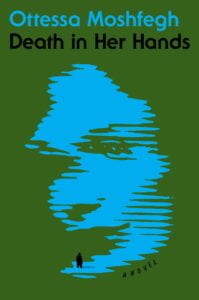Ottessa Moshfegh’s Death in Her Hands: Works of Imagination in the World
By Sharanya Das
DEATH IN HER HANDS
By Ottessa Moshfegh
Death in Her Hands follows 72-year-old widow Vesta Gul, who is an active observer and creator of a work of mystery and intrigue in the absence of those qualities in her own life. We begin by following Vesta follow a note in the woods: “Her name was Magda. Nobody will ever know who killed her. It wasn’t me. Here is her dead body” (Moshfegh 1). As she creates a rich, expansive mystery around this note which has no payoff in reality (there is no murder, there is no Magda, there is only a note), the reality of Vesta’s own life becomes increasingly blurred with this mystery born entirely of her imagination. Parallel to the mystery, she indulges in long, rambling monologues about her life which become increasingly disquieting as the people and events in her life which she nostalgically and warmly reminisces over are made out to be more sinister than originally thought. The characters she has created in her head to enrich and expand the mystery of the note seep into her interactions with real people, to whom she dangerously assigns the identities of characters within her created murder mystery.
There is a threshold of abnormality in Vesta’s behavior, which before crossed, readers empathize with and are seduced by, perhaps finding it, instead of unhinged, merely imaginative, warm, and sensitive to the world. And her behavior can genuinely be interpreted that way for a number of pages. Vesta is emotional and has a great capacity for being romantic, sweet, and maternal in her fantasies. Her affection for the Magda of the note is unquestionably earnest and deeply felt, but the fact remains that Magda is herself a creation of Vesta’s imagination. “Maybe she’d be out there, rowing across the lake, waving to me and smiling, alight in the sunset, her face a beam of golden light, like an angel, like some kind of magic girl” (Moshfegh 105). It is this romance and sweetness which lead readers to initially see their own truths reflected in her insanity without sensing danger: yes, this is the intensity with which feelings are felt; this is what it feels like to lose oneself in one’s imagination, in a work of art, in one’s emotions.
The most surprising thing about the novel is that Moshfegh masterfully brings the reader to not only expect the truly delusional and macabre but find it normal, and to see Vesta’s imagined narrative as the narrative itself. Readers find themselves feeling comfortable with Vesta’s actions until a breaking point. Perhaps it is the moment when she types into AskJeeves: “How does one solve a mystery?” (Moshfegh 78), or when she assigns to a nervous teenage boy the identity of Blake, assuming there to be an understanding between them based on the manufactured facts of a nonexistent mystery only she knows in front of his very own mother (Moshfegh 172). It makes readers reckon with how fantastical, obsessive, and indulgent normal people are. We accept that Vesta exists simply because Moshfegh told us so. We indulge in and analyze the details of her universe. What is the difference between a work of art — a work of imagination, simply a created universe with thoughtfully laid out hyper specific details — and Vesta’s mystery? Is Vesta’s narrative not simply Moshfegh’s narrative, the latter of which is unquestionably a work of art?

